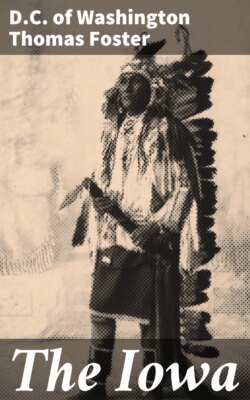Читать книгу The Iowa - D.C. of Washington Thomas Foster - Страница 4
На сайте Литреса книга снята с продажи.
PREFACE
ОглавлениеThe material forming the greater part of the present monograph is reprinted verbatim et literatim from certain portions of volume 1, Numbers 1, 2, and 3, Washington, November 30, 1876, of Foster’s Indian Record and Historical Data. The complete work so far as carried out consists only of the three parts here mentioned, printed in folio and comprising four numbered pages each. The editor, Dr. Thomas Foster, who termed himself “Indian historiographer” hoped to be able to publish the sheet weekly “should funds permit.” Evidently lack of finances or the small amount of interest shown in the venture determined against its continuance as it ceased with the third issue.
During Foster’s connection with the Indian Bureau at Washington, John Q. Smith held the position of Commissioner of Indian Affairs and it is not improbable looked with little favor on the scheme. In any event the Record is a desideratum in most collections and as such, even a portion of it may not be amiss in this reprint. Unfortunately its short existence did not permit of finishing the sketches of the Iowa or Winnebago, though it would appear that in the instance of the former but little more would have been added. It is hoped however, that in the foreword the more necessary data are given and that it is appropriately terminated.
The actual worth of the Indian Record is slight. Foster’s idea with reference to several monographs relating wholly or in part to certain tribes was a worthy one and could be executed to advantage even at this date. The two treatises attempted in his short-lived publication were on the Iowa and their parent stock, the Winnebago, although several shorter tribal sketches, as for example those on the Attacapa,1 Oroyelles,2 Arapahoes,3 and Eries4 are included among other features, these being as scattered notes through the forty-eight columns and of more or less value, particularly as concerns the linguistics.5 It is evident from his Introduction that Foster must have had many difficulties to contend with, especially in the matter of procuring suitable faces of type for his Indian vocabularies as well as in the matter of actual printing. At the best the work is poorly done. The proof-reading is wretched and the statements of fact often in grave error. Abject carelessness in the matter of transcription appears without excuse, hence quoted portions through the present text have invariably been read and compared with the originals, obviously enhancing the value of such a reissue. Although a praiseworthy effort for the period and due every consideration at this time, a project of the kind attempted today would fail ingloriously unless handled with requisite care.
In the absence of any cognate facts referring in detail to the Iowa tribe it has been deemed best to reprint Foster’s sketch in its entirety from the Record and to add to it, as appendices, some features which will be of special interest and value to the student of American aboriginal history and ethnology. In this textual portion will be found much from Schoolcraft’s Indian Tribes of the United States, also extracts, some of considerable length, from the first volume of the Minnesota Historical Society’s Collections, 1850–56, and Neill’s History of Minnesota. Nevertheless such facts as are garnered from sources of this character although purloined, are to be welcomed, and in a certain sense it may be considered fortunate that all of the material is not wholly original.
In the introductory sketch following this, an attempt has been made to gather all material readily available on the Iowa tribe. The writer acknowledges his indebtedness to the Bureau of American Ethnology, without assistance from which no authentic or in any way exhaustive sketch on any subject connected with the Indian question could be accomplished. The many references in the form of foot-notes have been verified with the greatest care. In many instances the meanings in the original are ambiguous. In the present form this fault is rectified and it is hoped that the concise yet lucid account of this important branch of the great Siouan family may assist in giving it some of that prominence to which it should rightfully aspire. A list of some of the more famous warriors is included as an appendix, and though incomplete and taken in part from printed records it will show that the tribe numbered among its members men who were famous outside of their own precincts, and these names may inspire some future historian to delve even more deeply into those archives that are known to be only memoirs of a past existence.
Students of Iowa history or of the Indians of the central west can ill afford to overlook a work on the Indian tribes by A. R. Fulton entitled The Red Men of Iowa. The volume is now scarce but fortunately the writer has been able to use it and is glad to acknowledge its excellence. To Worthington C. Ford, of the Massachusetts Historical Society, and to W. H. Holmes, of the Smithsonian Institution, James Mooney and F. W. Hodge of the Bureau of American Ethnology, he is also indebted and wishes publicly to express his thanks for their kindly interest.
